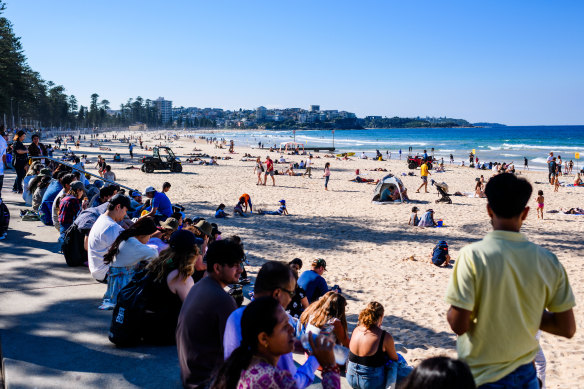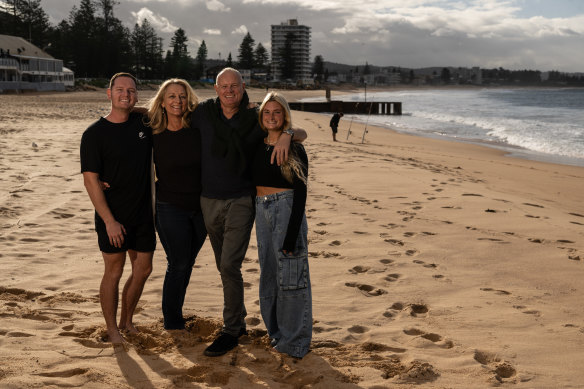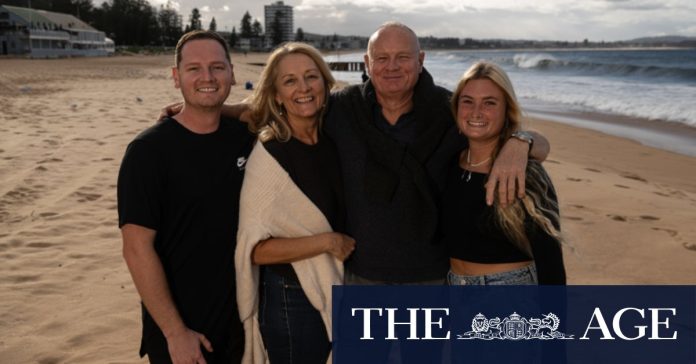[ad_1]
Even though many people’s wealth is stored in their housing, Tjondro emphasised that the report does not conclude that high house prices equal higher wellbeing.
“It’s certainly not a good thing that it’s very hard for many people to get into the housing market,” she said.

A crowded Manly beach in March.Credit: James Brickwood
“The messaging that we want to avoid is that it costs more to live in higher wellbeing areas.”
Instead, the report offers a prompt to consider how to make high wellbeing areas more affordable, such as through improved housing supply, transport connections and investment in infrastructure. And on the flip side, how to raise the wellbeing of more affordable areas, such as through policies that encourage more equal gender participation to reduce the gender pay gap, or reduce barriers to workforce participation among communities that have a large migrant profile.
Northern beaches locals Jenny Connah, 57, and Dave Connah, 58, have lived there for decades and have no plans of moving because the area offers the perfect mix of amenities for the couple, their family and their grandchildren.
“I’ve lived here most of my life. It has everything you need. You have national parks all around you and the beach at your doorstep. It’s the best of both worlds. It has great services such as hospitals,” Jenny said, who works for her father.

Jenny Connah and her husband Dave with children Penny and Tim at Collaroy Beach on Sydney’s northern beaches where they have owned a house for 25 years.Credit: Nick Moir
The pair acknowledge housing is expensive in this pocket of Sydney and has skyrocketed since they bought in the late 1980s.
“We’ve had this house for 30 years. We paid $365,000, and it’s probably a $3.5 million house now. That gives an idea of how house prices have escalated,” Dave said, who owns a workshop in Brookvale. “The price is relative to what it has to offer because everybody wants to live here. It’s definitely more expensive than Parramatta and that’s because you’re living right on the beach.”
Northern beaches veteran real estate agent John Cunningham said the region offers 13 coastal beaches and harbours at both ends, but is not that far from the CBD.
“It’s a place where people aspire to live, it’s a place where they feel is a great place to bring up kids and it’s a great place to retire,” the Cunninghams managing director said.
Loading
“You’ve got more people wanting to live here than leave here.”
He said about 30 per cent to 40 per cent of his home purchasers are out-of-area buyers, often from the lower north shore, inner west, upper north shore, eastern suburbs or Hills District. He hopes for a good outcome from the state government’s medium-density push that will add more terrace houses and increase choices for buyers.
In terms of price, he said buyers in Manly might find a one-bedroom apartment from $1 million, but a serious house buyer would expect to pay $4 million or more, anywhere up to $20 million-plus.
At a lower price point, a three- to four-bedroom house in Newport, Bilgola Plateau or Avalon could be bought for just over $2 million, although $2.5 million would be common in Avalon. Entry-level buyers may find a Dee Why one-bedroom for $700,000, he said.
On the lower north shore, Belle Property Lane Cove principal James Bennett said the suburb of Lane Cove offers a village environment with restaurants, shopping and the park.
The direct buses to the city and the choice of primary schools are also attractive to home buyers.
He said 40 per cent to 50 per cent of home buyers there come from the lower north shore, with many from the inner west or from further north. Many are young families buying their second homes.
He said knockdown rebuilds in Lane Cove can cost $2.6 million and up, liveable entry-level houses sell for $3 million to $3.3 million, and quality family homes range from the high $3 millions up to $6 million.
[ad_2]
Source link


